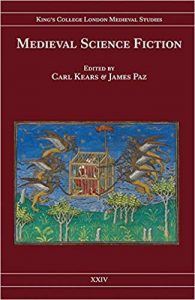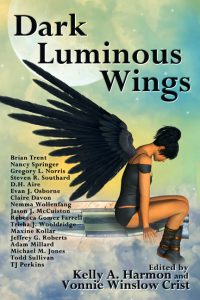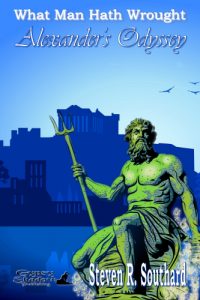Can Science Fiction trace its origins back further than Jules Verne? Further than Edgar Allan Poe? Further than Mary Shelley? Could you have read SciFi books if you lived in the Middle Ages?
 Medieval scholars Carl Kears and James Paz think so. They wrote a fascinating article in The Conversation called “Science fiction was around in medieval times – here’s what it looked like.” They also co-wrote the book Medieval Science Fiction.
Medieval scholars Carl Kears and James Paz think so. They wrote a fascinating article in The Conversation called “Science fiction was around in medieval times – here’s what it looked like.” They also co-wrote the book Medieval Science Fiction.
Their article cites some fascinating medieval examples of what we’ve come to know as science fiction. Moreover, some of these examples may be familiar to readers of stories by (ahem) me.
 They reference “…the story of Eilmer the 11th-century monk, who constructed a pair of wings and flew from the top of Malmesbury Abbey.” My readers know all about Brother Eilmer from my fictionalized account of this legend in “Instability” which appears in the anthology Dark Luminous Wings.
They reference “…the story of Eilmer the 11th-century monk, who constructed a pair of wings and flew from the top of Malmesbury Abbey.” My readers know all about Brother Eilmer from my fictionalized account of this legend in “Instability” which appears in the anthology Dark Luminous Wings.
 The article’s authors also cite “…medieval romances that feature Alexander the Great…exploring the depths of the ocean in his proto-submarine.” Once again, readers will recall my story “Alexander’s Odyssey” in which the sea-god Poseidon becomes angry with Alexander for invading his realm.
The article’s authors also cite “…medieval romances that feature Alexander the Great…exploring the depths of the ocean in his proto-submarine.” Once again, readers will recall my story “Alexander’s Odyssey” in which the sea-god Poseidon becomes angry with Alexander for invading his realm.
Wait, some of you are thinking, Alexander the Great didn’t live in medieval times! True, but his ancient Greek contemporaries never mentioned his descent in a diving bell. Arabic writers in the Middle Ages became fascinated with Alexander and fantasized all sorts of stories about him. Among those was the submarine tale.
Here are some other examples of books one might classify as Medieval Science Fiction:
• Roman de Troie, written by Benoît de Sainte-Maure in the 12th Century. It features automata.
• Theologus Autodidactus, written by Ibn al-Nafis in the late 13th Century. In it, the main character is spontaneously generated, rather than born. He predicts the future, uses his reason and senses to deduce the religion of Islam, and explains bodily resurrection using cloning.
• One Thousand and One Nights, compiled between the 9th and 14th Centuries. It mentions immortality, interplanetary travel, underwater breathing capability, and humanoid robots.
• The Travels of Sir John Mandeville, written by Sir John Mandeville in the 14th Century. It includes automata, alternate human species, and diamonds that reproduce sexually.
• “The House of Fame” a poem written by Geoffrey Chaucer in the late 14th Century. In it, a house is constructed such that all sound flows into it. The occupants can hear all noises from everywhere.
You might think I’m stretching things to call a story “Science Fiction” if it dates from a time before the development of Science. If SciFi is concerned with potential future technological or scientific advances, then an author couldn’t possibly write in that genre before Galileo came up with the scientific method in the early 17th Century. Right?
Well, maybe, but the genre of science fiction is quite broad, and considering the modern stories that get pigeonholed there, it seems unfair not to include the examples I’ve given above and those cited by Kears and Paz.
Living in the 21st Century, most of us regard Science Fiction as a modern genre, no more than two centuries old. If we could converse with some well-read folks from the 5th through 15th Centuries, they might disagree. Of course, if you do have such a conversation somehow, please tell—
Poseidon’s Scribe
